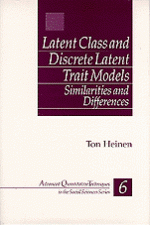Latent Class and Discrete Latent Trait Models
Similarities and Differences
- Ton Heinen - Tilburg University, Netherlands
Quantitative/Statistical Research (General)
However, what are the similarities and differences between the latent class model and latent trait models? Through a careful examination of these issues, Ton Heinen explores topics such as: how to estimate the parameters of latent class analysis models and latent trait models; methods for model selection; and ways to examine the correspondence between discrete latent trait models and certain restricted latent class models. In addition, he reviews log-linear models, latent trait models, a number of restricted latent class models, as well as procedures for the estimation of parameters for these models.
"Although there are differences between latent class and latent trait models, the author of this very readable book delineates the similarities between these modeling approaches."
